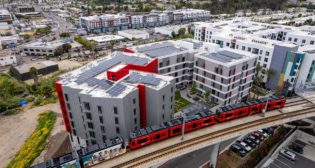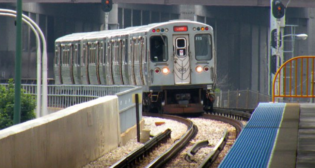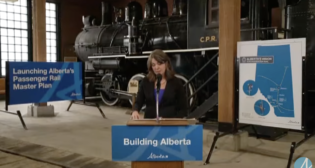
Transit Briefs: Brightline, LACMTA, Metrolinx, SEPTA, Sound Transit
Written by Marybeth Luczak, Executive Editor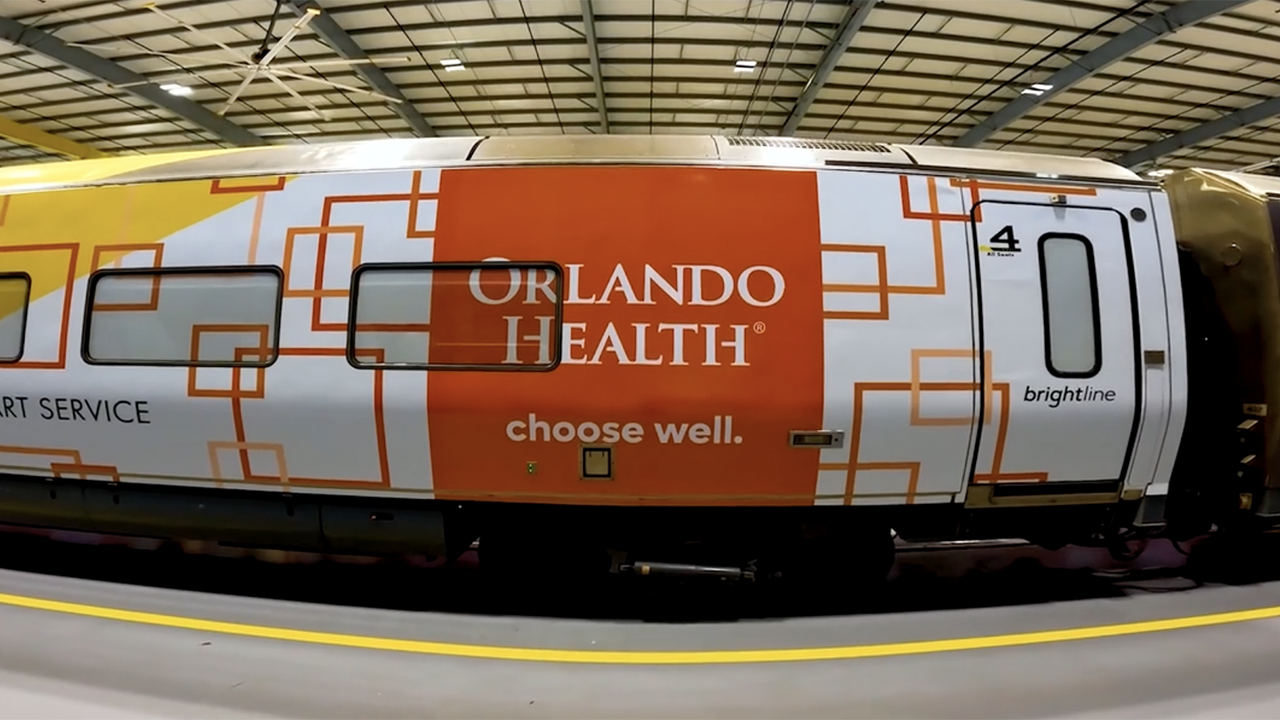
Brightline on Nov. 1 provided a first look at a four-coach Orlando Health-branded train. (Screen Grab from Brightline Video)
Brightline, Florida’s private-sector passenger railroad, unveils an Orlando Health-branded train. Also, Los Angeles County Metropolitan Transportation Authority (LACMTA) releases the Measure M five-year comprehensive assessment and equity report; ST Engineering wins platform screen door contract for Metrolinx’s Ontario Line; Southeastern Pennsylvania Transportation Authority (SEPTA) will stop accepting fare tokens next year; and Sound Transit’s new fare compliance policy takes effect later this month.
Brightline
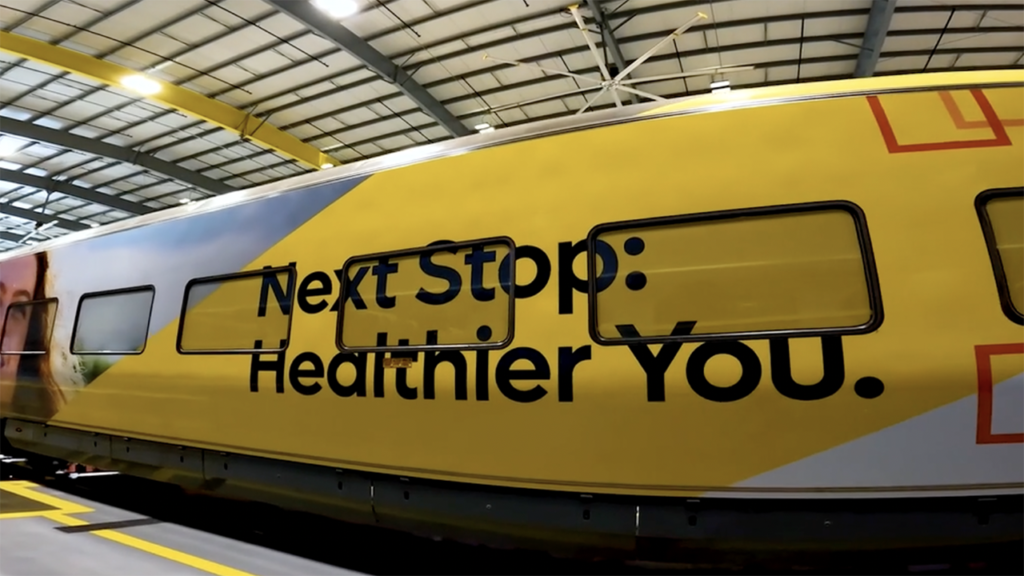
Brightline on Nov. 1 celebrated its multi-year partnership with Orlando Health with an unveiling event of its new Orlando Station name “Brightline Orlando Station in Partnership with Orlando Health” and revealing the official Orlando Health-branded Brightline train (see four-car train wrap above). Orlando Health is the official “health and wellness partner” of Brightline Orlando as well as station naming partner. Orlando Health’s partnership also includes brand representation at Brightline Orlando station and visibility on Brightline collateral and digital platforms. Additionally, Orlando Health will collaborate with Brightline as the company develops its corporate social responsibility initiatives in the region.
The railroad on Sept. 22 launched service from Miami to the Orlando International Airport in central Florida. Located adjacent to the airport’s new Terminal C, the Orlando Station stands three-stories tall, including a 72,000-square-foot platform area. It connects directly to the airport’s Parking Garage C, which will have more than 350 parking spaces marked for Brightline riders, and provides direct access to airport terminals A and B via the airport Terminal Link (automated people mover) in less than five minutes, according to Brightline.
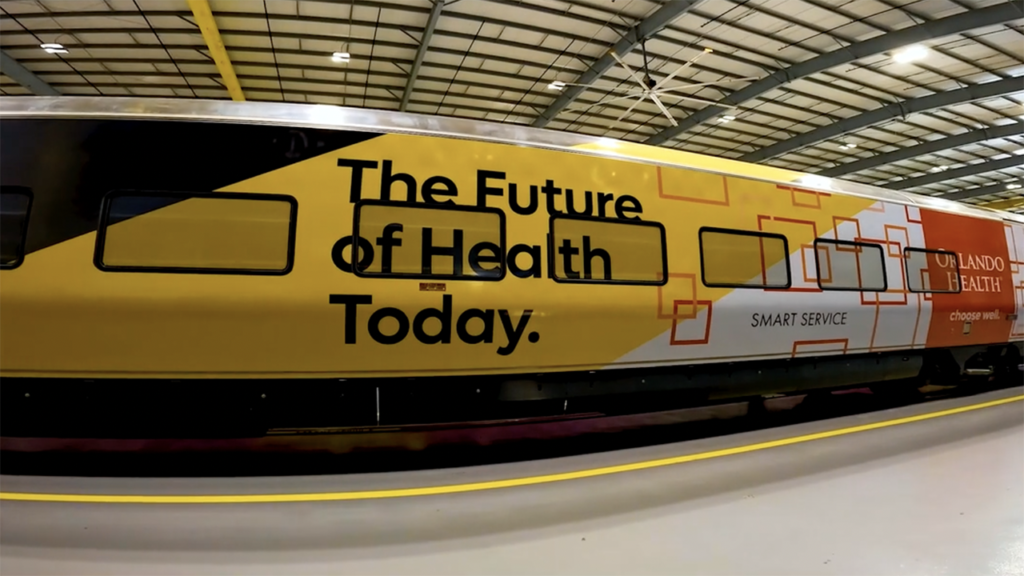
“This partnership exemplifies the remarkable synergy that can emerge when leaders in healthcare and transportation join forces,” Brightline President Patrick Goddard said. “I applaud Orlando Health for its vision and we look forward to working together to connect the state of Florida.”
“The Orlando Health-branded Brightline train represents our partnership of connectivity, promotes health awareness and is our visual commitment to providing high-quality care,” said Andrew Snyder, Orlando Health Senior Vice President, Marketing and Communications. “Patients outside of Central Florida can access our world-class healthcare system through the region’s first high-speed rail system. We are excited to showcase our trailblazing collaboration with Brightline.”
“Powerful partnerships like this help to advance our region,” said Kevin J. Thibault, CEO of the Greater Orlando Aviation Authority. “Congratulations to both Brightline and Orlando Health on their shared vision to promote community engagement and connectivity, which reflects Orlando International Airport’s mission to seamlessly connect Florida and the world through exceptional experience, collaboration, and creativity.”
In October, Brightline began running 30 trains daily with 15 daily departures from Miami and Orlando. The company also launched its new All-Station Shared pass, offering set pricing for multiple trips between Brightline’s Orlando and five South Florida stations. Additionally, Brightline formally launched a Request for Proposals last month for a new station planned for the Treasure Coast of Florida.
LACMTA
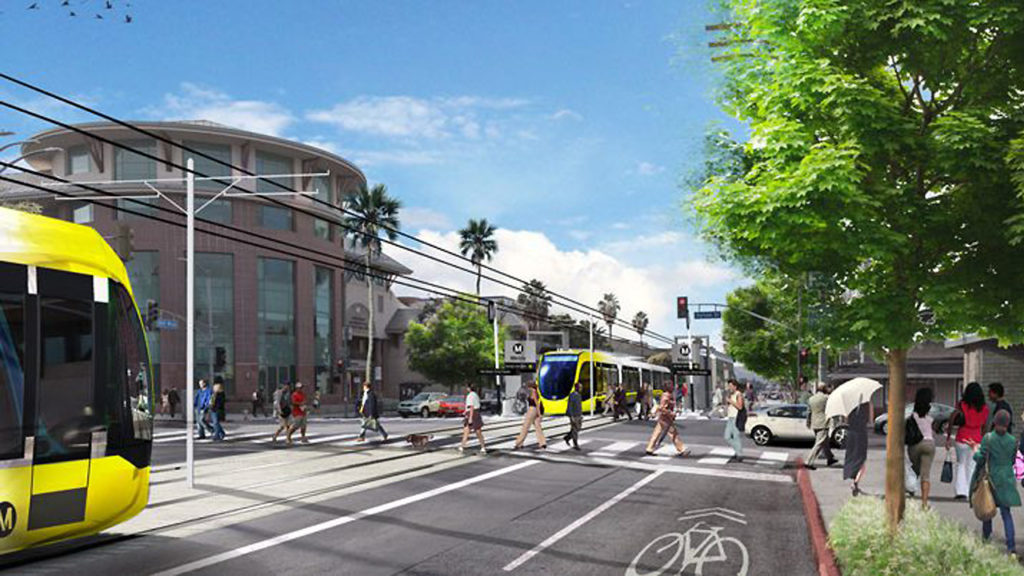
LACMTA on Nov. 1 issued its first assessment and equity report on Measure M, a sales tax supported by more than 70% of voters in 2016, to invest in Los Angeles and an improved transportation system. The 189-page report provides an overview of the first five years of Measure M funding (July 2017-June 2022), and “a fresh approach to assessing sales tax revenue through an equity framework that focuses on people first and the role Measure M, and Metro by extension, play in quality-of-life outcomes,” according to the transit authority.
The Measure M Independent Taxpayer Oversight Committee (MMITOC) unanimously voted to accept the report’s findings and recommendations.
The Measure M Expenditure Plan was conceived as a road map to guide 40 years of transit investment in Los Angeles County, according to LACMTA, which noted that the measure’s original eight goals ranged from reducing traffic congestion, to expanding regional transit and improving neighborhood streets, allowing Angelenos to get around more safely and easily. While the transit authority said it was able to “shift gears” in response to the COVID-19 pandemic and other impacts, the related disruption shifted the baseline for Measure M, as well as the future of Los Angeles. This five-year assessment has primarily shown that LACMTA made “difficult course adjustments, while heightening its focus on equity and customer experience; however, the longer-term successes of these adaptations remain to be measured,” the transit authority reported.
The report concluded that overall, LACMTA has “advanced projects, programs, and services that address many of the Measure M goals, particularly congestion management, transit expansion, local infrastructure repair, and efforts around safety and affordability,” according to the transit authority. “Much was accomplished before and during the pandemic, but there is more work to be done.”
Los Angeles Mayor and LACMTA Board Chair Karen Bass said she “applauded” the transit authority “for its progress on these goals and for leading initiatives that are making public transportation more accessible, convenient and affordable.” Its ongoing programs “help bring down the costs of travel for K-12 and community college students, riders who are income eligible and riders with disabilities,” she noted.
“When LA County voters approved Measure M in 2016, they declared their intention to remake our region into a more equitable, multimodal, accessible, and economically prosperous place where the mobility benefits of transportation projects reached every corner of the county,” LACMTA CEO Stephanie Wiggins said. “Though the last five years have brought tremendous change, at Metro [LACMTA], our priorities related to Measure M remain the same: to deliver on our promises to LA County voters in an equitable, timely and cost-effective manner.”
About Measure M
According to LACMTA, Measure M outlined funding programs and major projects in the ordinance’s Expenditure Plan, mapping a 40-year forecast to advance the eight Measure M goals:
- “Improve freeway traffic flow; reduce bottlenecks and ease traffic congestion.
- “Expand the rail and rapid transit system; accelerate rail construction and build new rail lines; enhance local, regional and express bus service; and improve system connectivity.
- “Repave local streets, repair potholes, synchronize signals; improve neighborhood streets and intersections, and enhance bike and pedestrian connections.
- “Keep the transit and highway system safe; earthquake-retrofit bridges, enhance freeway and transit system safety, and keep the transportation system in good working condition.
- “Make public transportation more accessible, convenient, and affordable for seniors, students, and the disabled and provide better mobility options for the aging population.
- “Embrace technology and innovation; incorporate modern technology, new advancements, and emerging innovations into the local transportation system.
- “Create jobs, reduce pollution, and generate local economic benefits; increase personal quality time and overall quality of life.
- “Provide accountability and transparency; protect and monitor the public’s investments through independent audits and oversights.”
As part of the Measure M Ordinance, LACMTA said five objectives were identified for assessment and approved by the Board in early 2023:
- Assess LACMTA’s “performance on the efficiency and effectiveness in delivering Measure M projects and programs.”
- “Identify and evaluate any potential barriers in the delivery of the Expenditure Plan.”
- “Identify and evaluate opportunities for process improvement.”
- “Identify and evaluate best practices to be used going forward.”
- “Identify and evaluate any organizational changes needed to improve coordination.”
Adopted in 2018, LACMTA’s Equity Platform is said to guide equity implementation across the broad scope of the transit authority’s work and services provided. “While a moral imperative, advancing equity also improves health and economic outcomes for marginalized communities, by increasing access to education, economic opportunity, health and social services, and other quality of life resources,” LACMTA said.
“Beyond the assessment criteria laid out in the Measure M ordinance, this report takes a deeper dive into issues related to equity and Angelenos’ quality of life,” Stephanie Wiggins said.
Among the reports key takeaways:
- Efficiency and effectiveness in delivery. In its first five years, Measure M sustained LACMTA’s service and project delivery by strengthening Los Angeles’ “local match” competitiveness for other grants, helping to leverage over $3 billion in state and federal funding in the five-year period, according to the transit authority.
- Potential barriers in the delivery. During the COVID-19 pandemic, LACMTA said it “worked to adapt and pivot,” adopting new strategies for project delivery and strategically leveraging funding opportunities.
- Opportunities for process improvement. Led by its focus on equity and customer experience, LACMTA said it has “further prioritized community engagement in project planning processes, which sometimes impacted early project schedules but focused on community input and ownership for stronger future project outcomes.”
- Best practices to be used going forward. “The tumultuous change that characterized much of the five-year assessment period has underscored the value of adaptability, partnerships and equity for Measure M implementation,” according to LACMTA.
LACMTA said it “continues to work to incorporate equity into Measure M implementation, doubling down on reliable tactics, such as robust community engagement and equity data-driven service planning while initiating innovative ones, such as incorporating cultural competency strategies into project implementation for the East San Fernando Valley Light Rail Transit Corridor project.”
Organizational Changes
While LACMTA said it has adapted in response to many external and internal changes, “the foundational element for future success remains in having people to do the work.” Early in the assessment period, the transit authority underwent a hiring freeze, an incremental return to hiring only essential positions, and incentivized retirement. Since then, LACMTA conducted a 2021 agency-wide reorganization of major internal departments that consolidated departments. As part of its priority to restore service for riders, the transit authority said it “initiated an aggressive bus operator hiring campaign, and has worked to streamline hiring processes where possible.” According to LACMTA, the operator hiring push has shown early success, with transit service returning to pre-pandemic levels in late 2022 (shortly after the five-year assessment period). LACMTA said it has focused efforts to rebuild office workers and professional services staff. Future efforts to build back its workforce “will have major impacts on Measure M implementation, including project budgets and schedules,” according to the transit authority.
Metrolinx
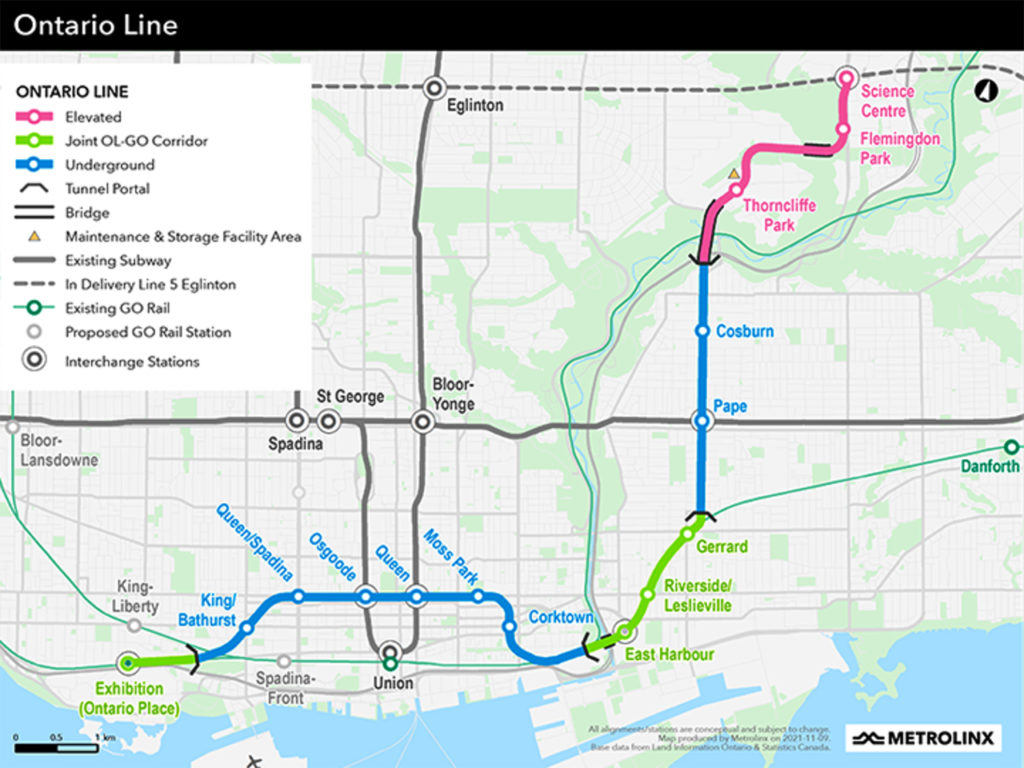
ST Engineering on Nov. 6 reported that its Urban Solutions business has secured a contract to provide the AGIL Platform Screen Door (PSD) system for all 15 stations of the Ontario Line under construction in Toronto, Canada. It will deliver 360 sets of full-height PSDs for the new 9.7-mile line, which comprises a mix of tunneled, above-ground and elevated stations. ST Engineering said its Urban Solutions’ contracted scope is expected to begin in late 2023, with PSD installation planned to begin in 2028.
“Certified for Safety Integrity Level 3 (SIL3) across all safety critical functions, the AGIL PSD solution is capable of withstanding harsh weather conditions including icy weather and heavy snowfall,” according to ST Engineering. “The PSDs serve as vital safety barriers, enhancing commuter safety and reducing train delays due to unauthorized track intrusions or fallen objects on the tracks.”
Further Reading: GTHA Update: Ontario Line, Kitchener-Waterloo, Yonge North, Eglinton Crosstown
SEPTA
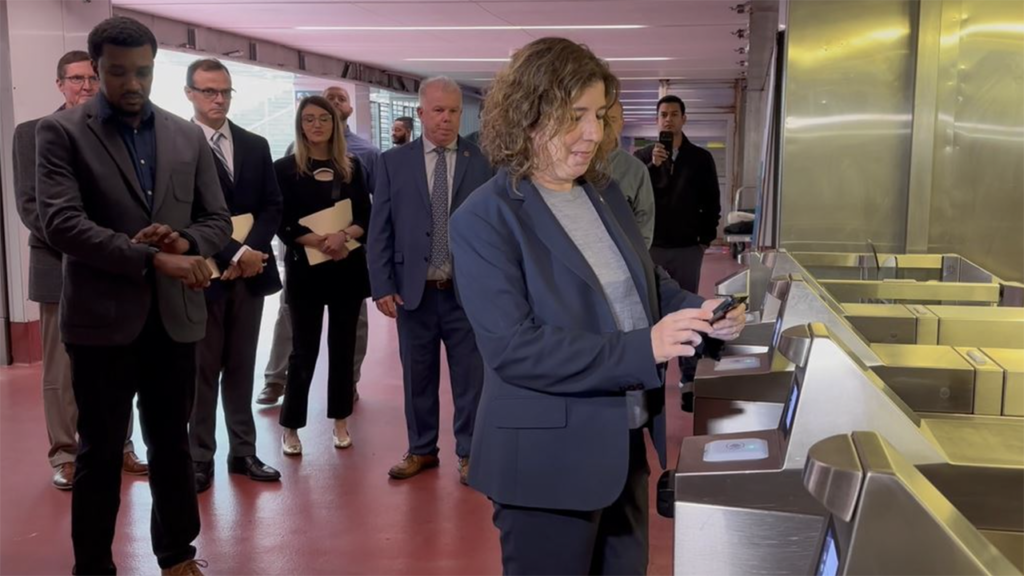
As of Jan. 1, 2024, SEPTA will no longer accept tokens for fare payment. The sale of tokens ended in 2018; however, SEPTA has continued to accept tokens on buses and trolleys, and via fare kiosks located at stations and bus loops. Tokens are valued at $2 apiece and are not redeemable for cash.
SEPTA is encouraging riders to add the value of their tokens to a SEPTA Key card at a fare kiosk. Tokens can be used to load a pass to a Key card, or to add funds to the Travel Wallet feature. Travel Wallet can be used to pay for trips on all modes, including buses, trolleys, the Market-Frankford Line, the Broad Street Line, the Norristown High Speed Line, and Regional Rail.
SEPTA in September began rolling out contactless payment options on its trolley, rapid transit and bus services. Riders can now tap using their credit and debit cards, or mobile payment apps, at turnstiles and fare boxes. According to SEPTA, these contactless options offer the same benefits that had previously only been available with the SEPTA Key fare program—in particular, a discounted $2 one-way fare and up to two transfers.
Sound Transit
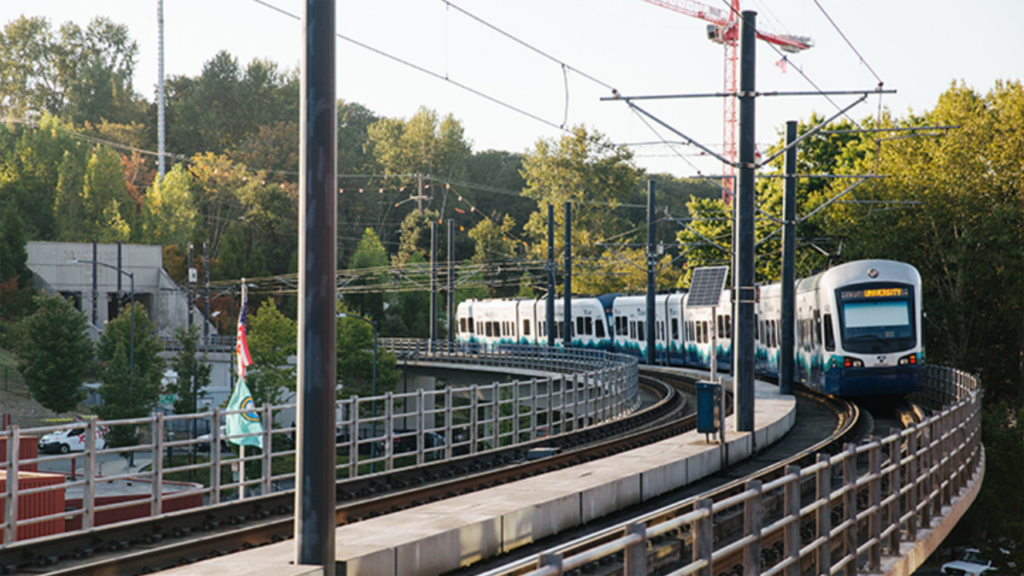
Starting Nov. 15, Sound Transit Fare Ambassadors will issue violations to riders found to be riding repeatedly without proof of payment, the Seattle, Wash.-based transit agency reported Nov. 1. Fare Ambassadors will continue to inform people about how to sign up for reduced fare programs and provide passenger service.
The Sound Transit Board in 2022 approved the updated fare compliance policy, which was developed in partnership with communities disproportionately impacted by the effects of fare nonpayment.
Under the policy, riders without proof of payment will receive two warnings in a 12-month period. Warnings issued to riders before Nov. 15 will be removed. All riders will start with zero warnings.
On the third and fourth interactions without proof of payment, riders will be issued violations that can be resolved with Sound Transit through non-monetary options such as an online class or engagement activity, or with a $50 fine for the third violation, and a $75 fine for the fourth, according to Sound Transit.
Repeat non-payment, which is five or more instances of riding without proof of payment in a 12-month period, will result in a civil infraction, which may be referred to the district court, Sound Transit reported.
Riders found riding without proof of payment must provide some form of identification for tracking purposes. ID can include:
- Valid state-issued identification card or driver’s license.
- Valid military identification.
- Valid passport or passport card.
- Tribal enrollment card.
- Current school or employment identification card that displays the full name.
- Library card.
- Utility bill, paystub, bank statement, government check, or government document displaying full name and current address.
- Hunting or fishing license.
- Medicare, Medicaid, or health insurance card.
According to Sound Transit, riders who do not provide valid ID will be asked to exit the train at the next station. Refusal to do so will result in a referral to security.
“We are committed to seeking non-punitive solutions and will continue to refine our programs to prioritize assistance and education,” Sound Transit said. “Additional procedures are currently under development, including direct referrals to social service teams and photo-documentation for those without valid fare and ID. These procedures are not final and would be launched with more information at a future date.”
The transit agency noted that it will continue to track the performance of the program to ensure it meets “equity goals and inspection targets.”
